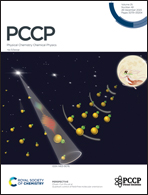A spectrophotometric study of the impact of pH and metal-to-ligand ratio on the speciation of the Pu(vi)-oxalate system†
Abstract
The oxalate ligand is prevalent throughout the nuclear fuel cycle. While the Pu(III)- and Pu(IV)-oxalate systems are well studied due to their use in plutonium metal and PuO2 production, the effect of oxalate on Pu(VI) remains understudied. Absorption spectroscopy was employed to probe the solution behavior of the Pu(VI)-oxalate system as a function of pH (1, 3, 7) and metal-to-ligand ratio (M/L; 10 : 1–1 : 10). Peak changes in the UV-vis-NIR spectra were associated with the formation of multiple Pu(VI)-oxalate species with increasing oxalate concentration. Some insight into identification of species present in solution was gained from the limited Pu(VI)-oxalate literature and comparisons with the assumed isostructural U(VI)-oxalate system. A peak in the UV-vis-NIR spectrum at 839 nm, which corresponds to the formation of a 1 : 1 PuO2(C2O4)(aq) complex, was observed and used to determine the formation constant (log β° = 4.64 ± 0.06). A higher coordinated Pu(VI)-oxalate peak at 846 nm was tentatively assigned as the 1 : 2 complex PuO2(C2O4)22− and a preliminary formation constant was determined (log β° = 9.30 ± 0.08). The predominance of both complexes was shown in speciation diagrams calculated from the formation constants, illustrating the importance of considering the Pu(VI)-oxalate system in the nuclear fuel cycle.



 Please wait while we load your content...
Please wait while we load your content...